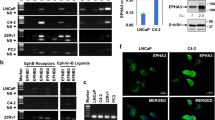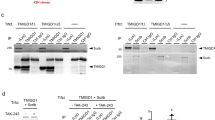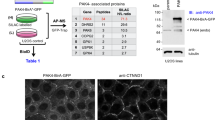Abstract
Members of the LAP protein family, LET-413 in Caenorhabditis elegans, Scribble in Drosophila melanogaster and Erbin, Lano, Densin-180 and hScrib in mammals, have conserved structural features. LET-413 and Scribble are junctional proteins involved in establishing and maintaining epithelial cell polarity. scribble also behaves as a neoplastic tumor suppressor gene. We show here that, in epithelial cells, hScrib is recruited at cell–cell junctions in an E-cadherin-dependent manner as shown by calcium switch assays in MDCK cells, re-expression of E-cadherin in MDA-231 cells treated by 5-Aza-2′-deoxycytidine (5Aza) and siRNA experiments. hScrib is restricted at the basolateral membrane of epithelial cells by its LRR domain and is enriched in Triton X-100-insoluble fractions. In breast cancers, most lobular tumors did not express hScrib and E-cadherin while ductal tumors had a less frequent downregulation of hScrib. Our data provide additional insights on the modalities of recruitment of hScrib at the cell–cell junctions and establish a potential link between the E-cadherin and hScrib tumor suppressors.
This is a preview of subscription content, access via your institution
Access options
Subscribe to this journal
Receive 50 print issues and online access
$259.00 per year
only $5.18 per issue
Buy this article
- Purchase on Springer Link
- Instant access to full article PDF
Prices may be subject to local taxes which are calculated during checkout









Similar content being viewed by others
References
Albertson R, Chabu C, Sheehan A and Doe CQ . (2004). J. Cell Sci., 117, 6061–6070.
Audebert S, Navarro C, Nourry C, Chasserot-Golaz S, Lecine P, Bellaiche Y, Dupont JL, Premont RT, Sempere C, Strub JM, Van DA, Vitale N and Borg JP . (2004). Curr. Biol., 14, 987–995.
Baas AF, Smit L and Clevers H . (2004). Trends Cell Biol., 14, 312–319.
Benton R and St Johnston D . (2003). Curr. Biol., 13, 1330–1334.
Bertucci F, Borie N, Ginestier C, Groulet A, Charafe-Jauffret E, Adelaide J, Geneix J, Bachelart L, Finetti P, Koki A, Hermitte F, Hassoun J, Debono S, Viens P, Fert V, Jacquemier J and Birnbaum D . (2004). Oncogene, 23, 2564–2575.
Berx G and Van Roy F . (2003). Breast Cancer Res., 3, 289–293.
Bilder D . (2004). Genes Dev., 18, 1909–1925.
Bilder D and Perrimon N . (2000). Nature, 403, 676–680.
Borg JP, Marchetto S, Le Bivic A, Ollendorff V, Jaulin-Bastard F, Saito H, Fournier E, Adelaide J, Margolis B and Birnbaum D . (2000). Nat. Cell Biol., 2, 407–414.
Dow LE, Brumby AM, Muratore R, Coombe ML, Sedelies KA, Trapani JA, Russell SM, Richardson HE and Humbert PO . (2003). Oncogene, 22, 9225–9230.
Droufakou S, Deshmane V, Roylance R, Hanby A, Tomlinson I and Hart IR . (2001). Int. J. Cancer, 92, 404–408.
Ginestier C, Charafe-Jauffret E, Bertucci F, Eisinger F, Geneix J, Bechlian D, Conte N, Adelaide J, Toiron Y, Nguyen C, Viens P, Mozziconacci MJ, Houlgatte R, Birnbaum D and Jacquemier J . (2002). Am. J. Pathol., 161, 1223–1233.
Graff JR, Herman JG, Lapidus RG, Chopra H, Xu R, Jarrard DF, Isaacs WB, Pitha PM, Davidson NE and Baylin SB . (1995). Cancer Res., 55, 5195–5199.
Grindstaff KK, Yeaman C, Anandasabapathy N, Hsu SC, Rodriguez-Boulan E, Scheller RH and Nelson WJ . (1998). Cell, 93, 731–740.
Huang YZ, Wang Q, Xiong WC and Mei L . (2001). J. Biol. Chem., 276, 19318–19326.
Jaulin-Bastard F, Arsanto JP, Le Bivic A, Navarro C, Vely F, Saito H, Marchetto S, Hatzfeld M, Santoni MJ, Birnbaum D and Borg JP . (2002). J. Biol. Chem., 277, 2869–2875.
Lallemand D, Curto M, Saotome I, Giovannini M and McClatchey AI . (2003). Genes Dev., 17, 1090–1100.
Laprise P, Viel A and Rivard N . (2004). J. Biol. Chem., 279, 10157–10166.
Lee S, Fan S, Makarova O, Straight S and Margolis B . (2002). Mol. Cell Biol., 22, 1778–1791.
Legouis R, Gansmuller A, Sookhareea S, Bosher JM, Baillie DL and Labouesse M . (2000). Nat. Cell Biol., 2, 415–422.
Legouis R, Jaulin-Bastard F, Schott S, Navarro C, Borg JP and Labouesse M . (2003). EMBO Rep., 4, 1096–1102.
Mantovani F, Massimi P and Banks L . (2001). J. Cell Sci., 114, 4285–4292.
Mathew D, Gramates LS, Packard M, Thomas U, Bilder D, Perrimon N, Gorczyca M and Budnik V . (2002). Curr. Biol., 12, 531–539.
Mizuno K, Suzuki A, Hirose T, Kitamura K, Kutsuzawa K, Futaki M, Amano Y and Ohno S . (2003). J. Biol. Chem., 278, 31240–31250.
Musch A, Cohen D, Yeaman C, Nelson WJ, Rodriguez-Boulan E and Brennwald PJ . (2002). Mol. Biol. Cell, 13, 158–168.
Nakagawa S and Huibregtse JM . (2000). Mol. Cell. Biol., 20, 8244–8253.
Nakagawa S, Yano T, Nakagawa K, Takizawa S, Suzuki Y, Yasugi T, Huibregtse JM and Taketani Y . (2004). Br. J. Cancer, 90, 194–199.
Nelson WJ . (2003). Nature, 422, 766–774.
Nourry C, Grant SG and Borg JP . (2003). Sci. STKE, 179, RE7.
Ohno H, Hirabayashi S, Iizuka T, Ohnishi H, Fujita T and Hata Y . (2002). Oncogene, 21, 7042–7049.
Roche JP, Packard MC, Moeckel-Cole S and Budnik V . (2002). J. Neurosci., 22, 6471–6479.
Santoni MJ, Pontarotti P, Birnbaum D and Borg JP . (2002). Trends Genet., 18, 494–497.
Strathdee G . (2002). Semin. Cancer Biol., 12, 373–379.
Vasioukhin V, Bauer C, Degenstein L, Wise B and Fuchs E . (2001). Cell, 104, 605–617.
Walikonis RS, Oguni A, Khorosheva EM, Jeng CJ, Asuncion FJ and Kennedy MB . (2001). J. Neurosci., 21, 423–433.
Zeitler J, Hsu CP, Dionne H and Bilder D . (2004). J. Cell Biol., 167, 1137–1146.
Acknowledgements
We are grateful to Dr T Nagase for the KIAA0147 cDNA, Dr R Kemler for E-cadherin-positive and -negative fibroblasts, Dr G Monges for human colon samples and R Galindo for cell sorting expertises. The Laboratory of Molecular Pharmacology is supported by INSERM, Institut Paoli-Calmettes, Ligue Nationale Contre le Cancer (Label Ligue), Fondation de France, Cancéropole PACA and ACI ‘Jeune Chercheur’. CN and SA are recipients of Conseil Régional/Ipsogen fellowships. SN is a recipient of a Ligue Contre le Cancer fellowship.
Author information
Authors and Affiliations
Electronic supplementary material
Rights and permissions
About this article
Cite this article
Navarro, C., Nola, S., Audebert, S. et al. Junctional recruitment of mammalian Scribble relies on E-cadherin engagement. Oncogene 24, 4330–4339 (2005). https://doi.org/10.1038/sj.onc.1208632
Received:
Revised:
Accepted:
Published:
Issue Date:
DOI: https://doi.org/10.1038/sj.onc.1208632
Keywords
This article is cited by
-
PHLPP isoforms differentially regulate Akt isoforms and AS160 affecting neuronal insulin signaling and insulin resistance via Scribble
Cell Communication and Signaling (2022)
-
The Scribble family in cancer: twentieth anniversary
Oncogene (2020)
-
Structural centrosome aberrations favor proliferation by abrogating microtubule-dependent tissue integrity of breast epithelial mammospheres
Oncogene (2016)
-
ZDHHC7-mediated S-palmitoylation of Scribble regulates cell polarity
Nature Chemical Biology (2016)
-
Rewiring cell polarity signaling in cancer
Oncogene (2015)



